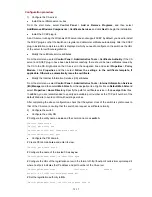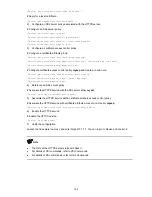
To do…
Use the command…
Remarks
Specify the preferred cipher
suite for the SSL client policy
prefer-cipher
{
rsa_3des_ede_cbc_sha
|
rsa_aes_128_cbc_sha
|
rsa_aes_256_cbc_sha
|
rsa_des_cbc_sha
|
rsa_rc4_128_md5
|
rsa_rc4_128_sha
}
Optional
rsa_rc4_128_md5
by default
Specify the SSL protocol
version for the SSL client policy
version
{
ssl3.0
|
tls1.0
}
Optional
TLS 1.0 by default
If you enable client authentication on the server, you must request a local certificate for the client.
Displaying and Maintaining SSL
To do…
Use the command…
Remarks
Display SSL server policy
information
display ssl server-policy
{
policy-name
|
all
}
Display SSL client policy
information
display ssl client-policy
{
policy-name
|
all
}
Available in any view
Troubleshooting SSL
SSL Handshake Failure
Symptom
As the SSL server, the device fails to handshake with the SSL client.
Analysis
SSL handshake failure may result from the following causes:
z
No SSL server certificate exists, or the certificate is not trusted.
z
The server is expected to authenticate the client, but the SSL client has no certificate or the
certificate is not trusted.
z
The cipher suites used by the server and the client do not match.
Solution
1) You can issue the
debugging ssl
command and view the debugging information to locate the
problem:
z
If the SSL server has no certificate, request one for it.
z
If the server certificate cannot be trusted, install on the SSL client the root certificate of the CA that
issues the local certificate to the SSL server, or let the server requests a certificate from the CA that
the SSL client trusts.
74-7







































